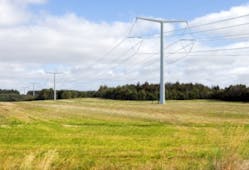The T-pylon, winner of an international design competition, will be offered on the proposed Hinkley Point C Connection. It may be the first time it is used in the UK.
The new pylon could help to address some of the concerns raised by the public about the connection’s impact on the landscape.
Residents feared that the new 400,000-V pylons needed to carry the wires would be much higher than those on the existing 132,000-V line currently running along the route. However, at 36 m high, the T-pylon is nearly one third shorter than the traditional 400,000-V lattice design.
National Grid had said previously that it hoped to offer the new pylon if it was ready in time to be used on the connection. Since the competition winner was chosen, engineers from both National Grid and the winning architects have worked hard to turn the concept into reality. They are now satisfied it will be ready.
Engineers from National Grid are now working with landscape experts to identify sections along the connection’s route where the new pylon would have the most benefit. It will then be included in the next round of public consultation in September when National Grid will be keen to hear people’s views.
Considering the T-pylon is just one of the ways National Grid is seeking to reduce the impact of the proposed Hinkley Point C Connection. For example, because of the project will allow an existing low voltage line to be removed and more than five miles of the proposed new line will go underground, overall there will be around 95 fewer pylons in the local landscape after the connection is built.
Peter Bryant, National Grid’s project manager, said, “The proposed Hinkley Point C Connection will play an important role in keeping the lights on in Britain but we do understand people’s concerns about the height of the pylons. The T-pylon gives us another option as we look for ways to reduce the visual impact of this vital project on the landscape.
“The steel lattice pylon has served us well and will continue to be used where appropriate but in September we’re looking forward to hearing people’s views on the T-pylon and where along the route it would be the best choice.”
Secretary of State for Energy and Climate Change, Edward Davey said: “To see T-pylon becoming a reality just 20 months after winning the competition, is a fantastic achievement for National Grid and Danish architects, Bystrup and I’d like to congratulate them on their progress. One of the key objectives of the Pylon Design Competition was to see if innovations in design and technology could improve an 85 year old structure, and one that has divided popular opinion since its inauguration in the 1920s.
“We face a significant challenge over the coming years connecting new electricity plants to our homes and businesses. Now communities can be offered a new choice and a radical departure from the traditional lattice. A smaller pylon, one third shorter than its predecessor, with different finishes allowing it to blend into the landscape – T-pylon is a striking and elegant design.
“I’m looking forward to seeing T-pylon put into service; a graceful, refined structure fit for the needs of our low carbon, 21st century.”
The proposed Hinkley Point C Connection which runs between Bridgwater and Avonmouth is needed to carry all the new electricity generation planned for the South West. This includes the new nuclear Hinkley Point power station which, if it goes ahead, will be one of the largest single generators in the country.
The T-pylon
The T-pylon was selected in a competition organized by the Royal Institute of British Architects, the Department of Energy and Climate Change and National Grid, to find a new, innovative design of pylon for the 21st Century.
The new design has a single pole and T shaped cross arms which hold the conductors and wires in a diamond ‘earring’ shape. Because of this innovative layout, the pylon can stand at a height of just 35 m, 10 to 15 m shorter than the traditional lattice towers.
The public saw some of the original conceptual images of the new pylon during the consultation events held as part of the planning for the power connection needed for the new Hinkley Point C nuclear power station. It prompted much interest from residents along the route, many of whom asked if it would be offered as an alternative to the traditional lattice pylon.



